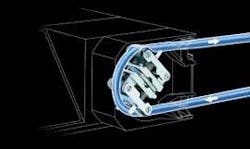Thames Water opted for peristaltic pumps for chemical dosing using ferric chloride to help meet AMP 3 and 4 requirements at its South East Provinces Wastewater plant in Cranleigh, UK.
Peristaltic dosing pumps solve potential difficulties in primary wastewater treatment plants that use the highly corrosive, yet cost-effective ferric chloride.
Ferric chloride is gaining in popularity as a coagulant and to remove odour-inducing sulphides, competing with alternatives such as alum (aluminium sulphate) or polymers. Many water companies, such as Thames Water in the UK, have been using ferric chloride for some time, but only recently have they begun to use the chemical as a flocculent to help them conform to the AMP 3 biochemical oxygen demand (BOD) parameter.
Thames Water’s South East Provinces Wastewater site in Cranleigh, UK, uses the Watson-Marlow Bredel 520UN/R2 peristaltic dosing pump for ferric chloride to be added as a flocculating agent. Very few pumps can handle the corrosive nature of ferric chloride, and even fewer can provide flexible control over flow and dosing.
Traditional pumping and dosing technologies require that pump size must be closely matched to the current need, leaving little room for manoeuvre if the dose rate must be increased significantly. They can fail without warning and contaminate the pump and surrounding area, which can create a major problem given the aggressive nature of ferric chloride. The installation of a suitably sized pump from the outset will enable almost any conceivable dose rate to be catered for, whatever the future requirements of the wastewater treatment plant.
One of the advantages of peristaltic pumps is that the only wetted part is the inside bore of the tube, which eliminates pump erosion and corrosion. Virtually no maintenance is required during the lifetime of a peristaltic pump other than occasionally replacing the tubing at low cost and with minimal downtime. The pump’s brushless DC motor will normally be specified to run continuously at approximately 50% of its rated maximum, so the motor needs little attention and consumes far less energy than a comparably-sized diaphragm metering pump driven mechanically, hydraulically or by solenoids. A further benefit of peristaltic pumps is that they provide smooth output.
Watson-Marlow Bredel offers a wide range of peristaltic pumps and tubing suitable for dosing ferric chloride. Depending on the application requirements, customers can either specify a stand alone pump with integral controller and readout, or pumps that can be connected to a SCADA (supervisory control and data acquisition) system. When integrated within an automated water treatment plant, input signals are usually 4-20mA, and there are 4-20mA outputs for signalling to a PLC - and onwards to the SCADA system. Watson-Marlow Bredel’s recently introduced 520 series incorporates a four-line LCD display that indicates data such as flow rate, motor speed and direction of rotation. A polyester powder-coated pump housing resists attack from most chemicals, including ferric chloride.
Ferric chloride (FeCl3, also known as iron chloride hexahydrate, ferric trichloride hexahydrate, ferric trichloride and iron chloride) is extremely aggressive, readily attacking most metals; however it is an excellent flocculent. When added to water, it hydrolyses into electropositive ferric hydroxide, attracting negatively charged colloidal substances and thereby forming flocs that clump together and precipitate out.
Through this mechanism, ferric chloride reduces biological oxygen demand and removes heavy metals, larvae eggs, pathogenic content, suspended solids and colloidal content. It precipitates phosphates, which is a major advantage in the fight to avoid eutrophication of rivers and lakes. Ferric chloride is not the cheapest flocculating agent, but it is widely viewed as the most cost-effective because the required dosage is lower.
Author’s Note
Philip Bolton is the manager of Water Industry Development at Watson-Marlow, located in Falmouth, Cornwall, UK. For more information, visit www.watson-marlow.co.uk




